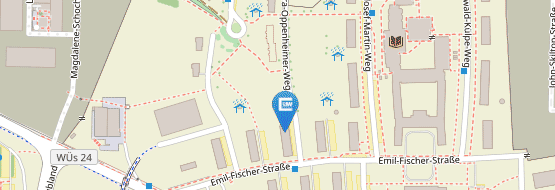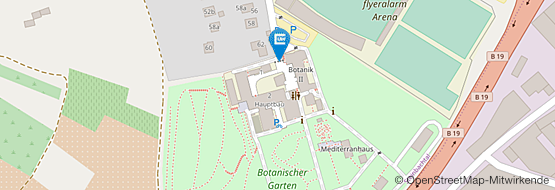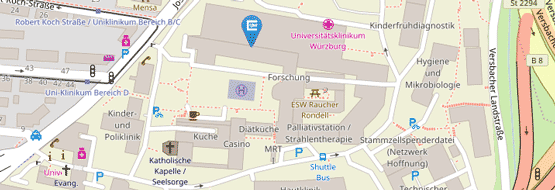Publications
2022[ to top ]
-
Emergence of spatially structured populations by area-concentrated search. . In Ecology and Evolution, 12(12). Wiley, 2022.
2021[ to top ]
-
Tracking the temporal dynamics of insect defoliation by high-resolution radar satellite data. . In Methods in Ecology and Evolution. Wiley Online Library, 2021.
-
Women temporarily synchronize their menstrual cycles with the luminance and gravimetric cycles of the Moon. . In Science Advances, 7(5), p. eabe1358. 2021.
2019[ to top ]
-
Multiple host use and the dynamics of host switching in hosttextendashparasite systems. . In Insect Conservation and Diversity. Wiley, 2019.
-
The Circadian Clock Improves Fitness in the Fruit Fly, Drosophila melanogaster. . In Frontiers in Physiology, 10, p. 1374. 2019.
-
Habitat loss and fragmentation increase realized predatortextendashprey body size ratios. . In Functional Ecology, 34(2), M. Spasojevic (ed.), pp. 534–544. Wiley, 2019.
-
Dispersal evolution in metacommunities of tri-trophic systems. . In Ecological Modelling, 395, pp. 28–38. 2019.
2018[ to top ]
-
Explaining the variability in the response of annual eusocial insects to mass-flowering events. . In Journal of Animal Ecology. 2018.
-
Suitable triggers for timing the transition from worker to sexual production in annual eusocial insects. . In Insectes Sociaux. 2018.
-
Size-dependent movement explains why bigger is better in fragmented landscapes. . In Ecology and Evolution, 8, pp. 10754–10767. 2018.
-
Information use during movement regulates how fragmentation and loss of habitat affect body size. . In Proceedings of the Royal Society of London (B), 285. 2018.
-
Eusociality outcompetes egalitarian and solitary strategies when resources are limited and reproduction is costly. . In Ecology and Evolution. 2018.
-
Exploratory behavior of re-orienting foragers differs from other flight patterns of honeybees. . In PLOS ONE, 13(8), pp. 1–14. Public Library of Science, 2018.
2017[ to top ]
-
Transgenerational effects of mild heat in Arabidopsis thaliana show strong genotype specificity that is explained by climate at origin. . In New Phytologist. 2017.
-
Saving the injured: Rescue behavior in the termite-hunting ant Megaponera analis. . In Science Advances, 3(4). American Association for the Advancement of Science, 2017.
-
Altered sex-specific mortality and female mating success: ecological effects and evolutionary responses. . In Ecosphere, 8(5), p. e01820-n/a. 2017.
-
Consequences of the genetic threshold model for observing partial migration under climate change scenarios. . In Ecology and Evolution, p. n/a-n/a. 2017.
-
Evolving mutation rate advances the invasion speed of a sexual species. . In BMC Evolutionary Biology, 17(150), pp. 1–10. 2017.
-
Mating timing, dispersal and local adaptation in patchy environments. . In Oikos. Blackwell Publishing Ltd, 2017.
2016[ to top ]
-
The downward spiral: eco-evolutionary feedback loops lead to the emergence of ‘elastic’ ranges. . In Ecography, 39(3), pp. 261–269. 2016.
-
Street lighting: sex-independent impacts on moth movement. . In Journal of Animal Ecology, 85, pp. 1352–1360. 2016.
2015[ to top ]
-
Evolution of dispersal distance: Maternal investment leads to bimodal dispersal kernels. . In Journal of Theoretical Biology, 365, pp. 270–279. 2015.
-
Evolutionary responses to climate change in parasitic systems. . In Global Change Biology, 21(8), pp. 2905–2916. 2015.
-
Relationships between wild bees, hoverflies and pollination success in apple orchards with different landscape contexts: Importance of wild pollinators in apple orchards. . In Agricultural and Forest Entomology, 18, pp. 68–75. 2015.
-
Coping with shorter days: Do phenology shifts constrain aphid fitness?. . In PeerJ, 3, p. e1103. 2015.
-
High female survival promotes evolution of protogyny and sexual conflict. . In PLoS ONE, 10(3), p. e0118354. 2015.
2014[ to top ]
-
Habitat structure mediates spatial segregation and therefore coexistence. . In Landscape Ecology, 29(4), pp. 593–604. 2014.
-
Photographic survey of the prey-choice of European Bee-eaters (Merops apiaster Linnaeus, 1758) in Hungary at three colonies. . In Ornis Hungarica, 21(2), pp. 38–46. 2014.
-
Spatially correlated extinctions select for less emigration but larger dispersal distances in the Spider Mite Tetranychus Urticae. . In Evolution, 68(6), pp. 1838–1844. 2014.
-
Gender-Specific Emigration Decisions Sensitive to Local Male and Female Density. . In The American Naturalist, 184(1), pp. 38–51. 2014.
-
Specialization and phenological synchrony of plant-pollinator interactions along an altitudinal gradient. . In Journal of Animal Ecology, 83(3), pp. 639–650. 2014.
-
Dispersal, evolution and range dynamics – a synthesis. . In Oikos, 123(1), pp. 3–4. 2014.
-
Where am I and why? Synthesizing range biology and the eco-evolutionary dynamics of dispersal. . In Oikos, 123(1), pp. 5–22. 2014.
-
Effects of timing and frequency of mowing on the threatened scarce large blue butterfly – A fine-scale experiment. . In Agriculture, Ecosystems & Environment, 196, pp. 24–33. 2014.
-
Optimal life-history strategy differs between philopatric and dispersing individuals in a metapopulation. . In The American Naturalist, 183(3), pp. 384–393. 2014.
2013[ to top ]
-
Kin competition as a major driving force for invasions. . In The American Naturalist, 181(5), pp. 700–706. 2013.
-
Prey density, value, and spatial distribution affect the efficiency of area-concentrated search. . In Journal of Theoretical Biology, 316, pp. 61–69. 2013.
-
Picky hitch-hikers: vector choice leads to directed dispersal and fat-tailed kernels in a passively dispersing mite. . In Oikos, 122(8), pp. 1254–1264. 2013.
-
Predicting range shifts under global change: the balance between local adaptation and dispersal. . In Ecography, 36(8), pp. 873–882. 2013.
-
From random walks to informed movement. . In Oikos, 122(6), pp. 857–866. 2013.
-
When can plant-pollinator interactions promote plant diversity?. . In The American Naturalist, 182(2), pp. 131–146. 2013.
-
Contrasting specialization–stability relationships in plant–animal mutualistic systems. . In Ecological Modelling, 258, pp. 65–73. 2013.
-
The genetic structure of populations of Metrioptera bicolor in a spatially structured landscape: effects of dispersal barriers and geographic distance. . In Conservation Genetics, 14(2), pp. 299–311. 2013.
-
Group tolerance, dispersal evolution, and the maintenance of polymorphism in recognition cues. . In Behavioral Ecology, 25(1), pp. 191–199. 2013.
2012[ to top ]
-
Unexpected benefit of a social parasite for a key fitness component of its ant host. . In American Naturalist, 179(1), pp. 110–123. 2012.
-
Risky movement increases the rate of range expansion. . In Proceedings of the Royal Society B-Biological Sciences, 279(1731), pp. 1194–1202. 2012.
-
Effects of grazing, vegetation structure and landscape complexity on grassland leafhoppers (Hemiptera: {Auchenorrhyncha}) and true bugs (Hemiptera: {Heteroptera}) in Hungary. . In Insect Conservation and Diversity, 5(1), pp. 57–66. 2012.
-
Different habitat selection by two sympatric Maculinea butterflies at small spatial scale. . In Insect Conservation and Diversity, 5(2), pp. 118–126. 2012.
-
Population dynamics of plant and pollinator communities: Stability reconsidered. . In American Naturalist, 179(2), pp. 157–168. 2012.
-
Concurrent evolution of random dispersal and habitat niche width in host-parasitoid systems. . In Ecological Modelling, 247, pp. 241–250. 2012.
-
Costs of dispersal. . In Biological Reviews, 87(2), pp. 290–312. 2012.
-
Evolution of dispersal in metacommunities of interacting species. . In Journal of Evolutionary Biology, 25(12), pp. 2511–2525. 2012.
-
Why are metapopulations so rare?. . In Ecology, 93(8), pp. 1967–1978. 2012.
2011[ to top ]
-
Set-aside promotes insect and plant diversity in a Central European country. . In Agriculture, Ecosystems & Environment, 141(3–4), pp. 296–301. 2011.
-
An updated algorithm for the generation of neutral landscapes by spectral synthesis. . In Plos One, 6(2), p. e17040. 2011.
-
Assortative mating counteracts the evolution of dispersal polymorphisms. . In Evolution, 65(9), pp. 2461–2469. 2011.
-
Scarce resources, risk sensitivity, and egalitarian resource sharing. . In Evolutionary Ecology Research, 13(3), pp. 253–267. 2011.
-
Risk sensitivity revisited: from individuals to populations. . In Animal Behaviour, 82(4), pp. 875–883. 2011.
-
Do all inter-patch movements represent dispersal? A mixed kernel study of butterfly mobility in fragmented landscapes. . In Journal of Animal Ecology, 80(5), pp. 1070–1077. 2011.
-
On the approximation of continuous dispersal kernels in discrete-space models: Approximating continuous dispersal on lattices. . In Methods in Ecology and Evolution, 2(6), pp. 668–681. 2011.
-
Range border formation in a world with increasing climatic variance. . In Evolutionary Ecology Research, 13(2), pp. 159–169. 2011.
-
Density-dependent dispersal and the formation of range borders. . In Ecography, 34(6), pp. 1002–1008. 2011.
-
The role of mobility for the emergence of diversity in victim-exploiter systems. . In Journal of Evolutionary Biology, 24(11), pp. 2473–2484. 2011.
2010[ to top ]
-
Evolution of dispersal polymorphism and local adaptation of dispersal distance in spatially structured landscapes. . In Oikos, 119(3), pp. 560–566. 2010.
-
On the elasticity of range limits during periods of expansion. . In Ecology, 91(10), pp. 3094–3099. 2010.
-
Information processing in models for density-dependent emigration: A comparison. . In Ecological Modelling, 221(3), pp. 405–410. 2010.
2009[ to top ]
-
What stops the ‘diploid male vortex’?—A simulation study for species with single locus complementary sex determination. . In Ecological Modelling, 220(13–14), pp. 1663–1669. 2009.
-
Sex-specific dispersal and evolutionary rescue in metapopulations infected by male killing endosymbionts. . In BMC Evolutionary Biology, 9, p. 16. 2009.
-
Sex-specific spatio-temporal variability in reproductive success promotes the evolution of sex-biased dispersal. . In Theoretical Population Biology, 76(1), pp. 13–18. 2009.
2008[ to top ]
-
Variation of dispersal agents? Frugivore assemblages and fruit handling in a typical ’bird-dispersed’ tree (Lannea acida, {Anacardiaceae}). . In Ecotropica-Bonn, 14(2), pp. 101–112. 2008.
-
Investigating movement within irregularly shaped patches: Analysis of mark-release-recapture data using randomization procedures. . In Israel Journal of Ecology & Evolution, 54(1), pp. 137–154. 2008.
-
Evolution of sex-biased dispersal: The role of sex-specific dispersal costs, demographic stochasticity, and inbreeding. . In Ecological Modelling, 219(1-2), pp. 226–233. 2008.
-
Male-killing endosymbionts: influence of environmental conditions on persistence of host metapopulation. . In Bmc Evolutionary Biology, 8, p. 243. 2008.
-
Restricted within-habitat movement and time-constrained egg laying of female Maculinea rebeli butterflies. . In Oecologia, 156(2), pp. 455–464. 2008.
-
Habitat quality matters for the distribution of an endangered leaf beetle and its egg parasitoid in a fragmented landscape. . In Journal of Insect Conservation, 13(2), pp. 165–175. 2008.
-
Egg distribution of the southern festoon (Zerynthia polyxena)(Lepidoptera, {Papilionidae}). . In Acta Zoologica Academiae Scientarum Hungaricae, 54, pp. 401–410. 2008.
-
Species-specific distribution of two sympatric Maculinea butterflies across different meadow edges. . In Journal of Insect Conservation, 13(2), pp. 223–230. 2008.
-
Process and measurement errors of population size: their mutual effects on precision and bias of estimates for demographic parameters. . In Biodiversity and Conservation, 17(14), pp. 3417–3429. 2008.
2007[ to top ]
-
Mosaic cycles in agricultural landscapes of Northwest Europe. . In Basic and Applied Ecology, 8(4), pp. 295–309. 2007.
-
Host plant finding in the specialised leaf beetle Cassida canaliculata: an analysis of small-scale movement behaviour. . In Ecological Entomology, 32, pp. 194–200. 2007.
-
Microhabitat preferences of Maculinea teleius (Lepidoptera: {Lycaenidae}) in a mosaic landscape. . In European Journal of Entomology, 104(4), p. 731. 2007.
-
An evolutionarily stable strategy model for the evolution of dimorphic development in the butterfly Maculinea rebeli, a social parasite of Myrmica ant colonies. . In American Naturalist, 169(4), pp. 466–480. 2007.
-
The generality of habitat suitability models: A practical test with two insect groups. . In Basic and Applied Ecology, 8(4), pp. 310–320. 2007.
-
Consequences of cyclic vegetation management for arthropod survival: Simulation experiments. . In Basic and Applied Ecology, 8(4), pp. 321–331. 2007.
-
Host plant finding in the specialised leaf beetle Cassida canaliculata: an analysis of small-scale movement behaviour. . In Ecological Entomology, 32(2), pp. 194–200. 2007.
2006[ to top ]
-
Multitrophic influences on egg distribution in a specialized leaf beetle at multiple spatial scales. . In Basic and Applied Ecology, 7(6), pp. 565–576. 2006.
-
Parameterizing, evaluating and comparing metapopulation models with data from individual-based simulations. . In Ecological Modelling, 199(4), pp. 476–485. 2006.
-
Habitat suitability models for the conservation of thermophilic grasshoppers and bush crickets—simple or complex?. . In Journal of Insect Conservation, 11(3), p. 221. 2006.
-
Evolution of local adaptations in dispersal strategies. . In Oikos, 114(3), pp. 544–552. 2006.
-
The control of emigration and its consequences for the survival of populations. . In Ecological Modelling, 190(3-4), pp. 443–453. 2006.
2005[ to top ]
-
Computer-generated null models as an approach to detect perceptual range in mark-re-sight studies - an example with grasshoppers. . In Ecological Entomology, 30(2), pp. 225–233. 2005.
-
Spatial patterns in species-area relationships and species distribution in a West African forest-savanna mosaic. . In Journal of Biogeography, 32(4), pp. 677–684. 2005.
-
Dispersal and establishment: spatial patterns and species-area relationships. . In Diversity and Distributions, 11(4), pp. 333–340. 2005.
-
Selection of large host plants for oviposition by a monophagous leaf beetle: nutritional quality or enemy-free space?. . In Ecological Entomology, 30(3), pp. 299–306. 2005.
2004[ to top ]
-
Patch density, movement pattern, and realised dispersal distances in a patch-matrix landscape - a simulation study. . In Ecological Modelling, 174(4), pp. 411–420. 2004.
2003[ to top ]
-
Forecasting plant migration rates: managing uncertainty for risk assessment. . In Journal of Ecology, 91(3), pp. 341–347. 2003.
-
Movement patterns of the bush cricket Platycleis albopunctata in different types of habitat: matrix is not always matrix. . In Ecological Entomology, 28(4), pp. 432–438. 2003.
2001[ to top ]
-
Evolution of reduced dispersal mortality and ’fat-tailed’ dispersal kernels in autocorrelated landscapes. . In Proceedings of the Royal Society B-Biological Sciences, 268(1465), pp. 385–391. 2001.
2000[ to top ]
-
Variability in dispersal distances generates typical successional patterns: a simple simulation model. . In Oikos, 90(3), pp. 612–619. 2000.
1999[ to top ]
-
Seed dispersal mechanisms and the vegetation of forest islands in a West African forest-savanna mosaic (Comoe National Park, Ivory {Coast}). . In Plant Ecology, 144(1), pp. 1–25. 1999.








